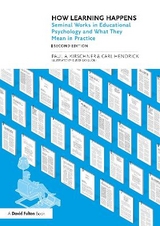
How Learning Happens
Routledge (Verlag)
978-0-367-18457-5 (ISBN)
- Titel erscheint in neuer Auflage
- Artikel merken
How Learning Happens introduces 28 giants of educational research and their findings on how we learn and what we need to learn effectively, efficiently, and enjoyably. Many of these works have inspired researchers and teachers all around the world and have left a mark on how we teach today.
Exploring 28 key works on learning and teaching, chosen from the fields of educational psychology and cognitive psychology, the book offers a roadmap of the most important discoveries in how learning happens. Each chapter examines a different work and explains its significance before describing the research, its implications for practice, how it can be used in the classroom and the key takeaways for teachers. Clearly divided into six sections, the book covers:
How the brain works and what this means for learning and teaching
Prerequisites for learning
How learning can be supported
Teacher activities
Learning in context
Cautionary tales and the ten deadly sins of education.
Written by two leading experts and illustrated by Oliver Caviglioli, this is essential reading for teachers wanting to fully engage with and understand educational research as well as undergraduate students in the fields of education, educational psychology and the learning sciences.
Paul A. Kirschner is Emeritus Professor of Educational Psychology at the Open University of the Netherlands as well as Guest Professor at the Thomas More University of Applied Science in Belgium. Carl Hendrick teaches at Wellington College, UK, and holds a PhD in Education from King’s College London.
Section 1. How Does Our Brain Work? 1. A Novice is Not a Little Expert 2. Take a Load Off Me 3. How Deep is Your Processing? 4. An Evolutionary View of Learning 5. One Picture and One Thousand Words Section 2. Prerequisites for Learning 6. What You Know Determines What You Learn 7. Why independent learning is not a good way to become an independent learner 8. Beliefs about Intelligence Can Affect Intelligence 9. … thinking makes it so 10. How you Think about Achievement Is more Important than the Achievement Itself 11. Where Are We Going and How Do We Get There? Section 3. Which Learning Activities Support Learning 12. Why Scaffolding is Not as Easy as it Looks 13. The Holy Grail: Whole Class Teaching and One-to-One Tutoring 14. Problem Solving: How to Find a Needle in a Haystack 15. Activities that Give Birth to Learning Section 4. The Teacher 16. Zooming Out to Zoom In 17. Why Discovery Learning is a Bad Way to Discover Things / Why Inquiry Learning Isn’t 18. Direct Instruction 19. Assessment for, not of learning 20. Feed up, Feedback, Feed Forward 21. Learning Techniques that Really Work Section 5. Learning in Context 22. Why Context is Everything 23. The Culture of Learning 24. Making Things Visible 25. It Takes a Community to Save $100 million Section 6. Cautionary Tales 26. Did You Hear the One About the Kinaesthetic Learner…? 27. When Teaching Kills Learning 28. The Medium is NOT the Message 29.The Ten Deadly Sins of Education
| Erscheinungsdatum | 10.03.2020 |
|---|---|
| Zusatzinfo | 9 Tables, black and white; 63 Line drawings, black and white; 69 Illustrations, black and white |
| Verlagsort | London |
| Sprache | englisch |
| Maße | 174 x 246 mm |
| Gewicht | 560 g |
| Themenwelt | Geisteswissenschaften ► Psychologie ► Pädagogische Psychologie |
| Sozialwissenschaften ► Pädagogik ► Allgemeines / Lexika | |
| Sozialwissenschaften ► Pädagogik ► Bildungstheorie | |
| Sozialwissenschaften ► Pädagogik ► Schulpädagogik / Grundschule | |
| Sozialwissenschaften ► Pädagogik ► Schulpädagogik / Sekundarstufe I+II | |
| ISBN-10 | 0-367-18457-5 / 0367184575 |
| ISBN-13 | 978-0-367-18457-5 / 9780367184575 |
| Zustand | Neuware |
| Informationen gemäß Produktsicherheitsverordnung (GPSR) | |
| Haben Sie eine Frage zum Produkt? |
aus dem Bereich



